Creating a simple LDAP application¶
LDAP presents a distributed tree of information¶
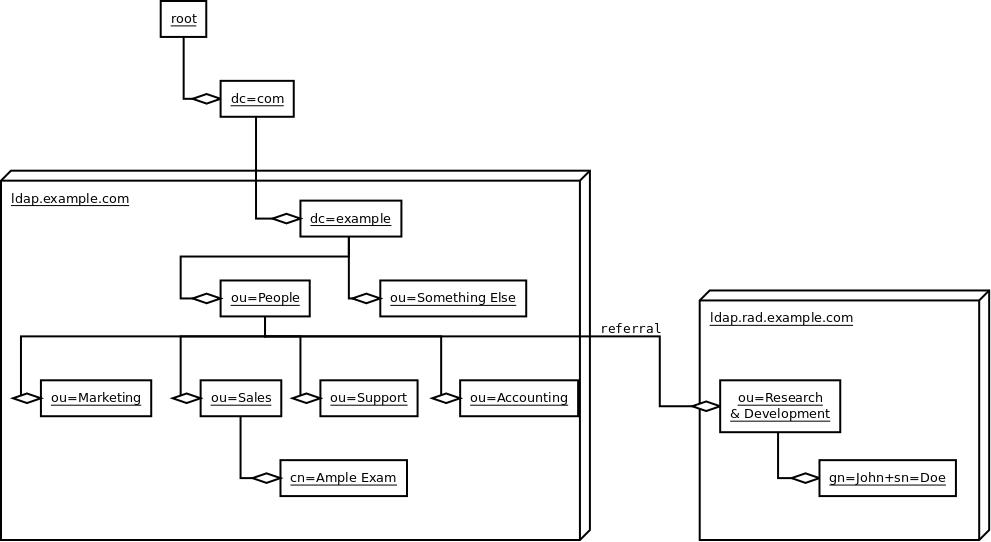
Writing things down, John Doe LDIF:
dn: gn=John+sn=Doe,ou=Research & Development,ou=People,dc=example,dc=com
objectClass: addressbookPerson
gn: John
sn: Doe
street: Back alley
postOfficeBox: 123
postalCode: 54321
postalAddress: Backstreet
st: NY
l: New York City
c: US
Writing things down, John Smith LDIF:
dn: gn=John+sn=Smith,ou=Marketing,ou=People, dc=example,dc=com
objectClass: addressbookPerson
gn: John
sn: Smith
telephoneNumber: 555-1234
facsimileTelephoneNumber: 555-1235
description: This is a description that can span multi
ple lines as long as the non-first lines are inden
ted in the LDIF.
Setting up an LDAP server in 5 seconds¶
Python, an easy programming language
Batteries included!
Python combines remarkable power with very clear syntax.
Runs on many brands of UNIX, on Windows, OS/2, Mac, Amiga, and many other platforms.
The first step¶
>>> from ldaptor.protocols.ldap import distinguishedname
>>> dn=distinguishedname.DistinguishedName(
... 'dc=example,dc=com')
>>> dn
DistinguishedName(listOfRDNs=(RelativeDistinguishedName(
attributeTypesAndValues=(LDAPAttributeTypeAndValue(
attributeType='dc', value='example'),)),
RelativeDistinguishedName(attributeTypesAndValues=(
LDAPAttributeTypeAndValue(attributeType='dc', value='com'),))))
>>> str(dn)
'dc=example,dc=com'
Ldaptor¶
Ldaptor is a set of pure-Python LDAP client programs, applications and a programming library.
It is licensed under the MIT (Expat) License.
Overview of Ldaptor¶

Preparing to connect¶
>>> from ldaptor.protocols.ldap import \
... ldapclient, ldapconnector
>>> from twisted.internet import reactor
>>> connector=ldapconnector.LDAPClientCreator(reactor,
... ldapclient.LDAPClient)
>>> connector
<ldaptor.protocols.ldap.ldapconnector.LDAPClientCreator
instance at 0x40619b6c>
Twisted¶
Twisted is an event-driven networking framework written in Python and licensed under the MIT (Expat) License.
Twisted supports TCP, UDP, SSL/TLS, multicast, Unix sockets, a large number of protocols (including HTTP, NNTP, SSH, IRC, FTP, and others), and much more.
Twisted includes many full-blown applications, such as web, SSH, FTP, DNS and news servers.
Connecting¶
>>> d=connector.connectAnonymously(dn,
... {dn: ('localhost', 10389)})
>>> d
<Deferred at 0x402d058c>
Deferreds¶
- A promise that a function will at some point have a result.
- You can attach callback functions to a Deferred.
- Once it gets a result these callbacks will be called.
- Also allows you to register a callback for an error, with the default behavior of logging the error.
- Standard way to handle all sorts of blocking or delayed operations.
Searching¶
>>> from twisted.trial.util import deferredResult
>>> proto=deferredResult(d)
>>> proto
<ldaptor.protocols.ldap.ldapclient.LDAPClient
instance at 0x40619dac>
>>> from ldaptor.protocols.ldap import ldapsyntax
>>> baseEntry=ldapsyntax.LDAPEntry(client=proto, dn=dn)
>>> d2=baseEntry.search(filterText='(gn=j*)')
>>> results=deferredResult(d2)
Results¶
>>> results
[LDAPEntry(dn='givenName=John+sn=Smith,ou=People,
dc=example,dc=com', attributes={'description': ['Some text.'],
'facsimileTelephoneNumber': ['555-1235'], 'givenName': ['John'],
'objectClass': ['addressbookPerson'], 'sn': ['Smith'],
'telephoneNumber': ['555-1234']}), LDAPEntry(dn=
'givenName=John+sn=Doe,ou=People,dc=example,dc=com',
attributes={'c': ['US'], 'givenName': ['John'], 'l': ['New York City'],
'objectClass': ['addressbookPerson'], 'postOfficeBox': ['123'],
'postalAddress': ['Backstreet'], 'postalCode': ['54321'],
'sn': ['Doe'], 'st': ['NY'], 'street': ['Back alley']})]
Results one-by-one¶
>>> results[0]
LDAPEntry(dn=
'givenName=John+sn=Smith,ou=People,dc=example,dc=com',
attributes={'description': ['Some text.'],
'facsimileTelephoneNumber': ['555-1235'], 'givenName': ['John'],
'objectClass': ['addressbookPerson'], 'sn': ['Smith'],
'telephoneNumber': ['555-1234']})
>>> results[3]
Traceback (most recent call last):
File "<stdin>", line 1, in ?
IndexError: list index out of range
LDIF output¶
>>> print results[0]
dn: givenName=John+sn=Smith,ou=People,dc=example,dc=com
objectClass: addressbookPerson
description: Some text.
facsimileTelephoneNumber: 555-1235
givenName: John
sn: Smith
telephoneNumber: 555-1234
Closing the connection¶
>>> proto.unbind()
Access to entry details¶
>>> smith=results[0]
>>> print smith.dn
givenName=John+sn=Smith,ou=People,dc=example,dc=com
>>> smith['givenName']
['John']
>>>
Object-oriented look at LDAP entries¶
A lot of similarities with OO programming languages, but some big differences, too.
An LDAP entry corresponds with an object.
Whereas object are usually instances of a single class, LDAP entries can “implement” multiple objectClasses.
All objectClasses can inherit zero, one or many objectClasses, just like programming classes.
All objectClasses have a root class, known as top; many object oriented programming languages have a root class, e.g. named Object.
All objectClasses are either STRUCTURAL or AUXILIARY; entries can only implement one STRUCTURAL objectClass.
Lastly, objectClasses of an entry can be changed at will; you only need to take care that the entry has all the MUST attribute types, and no attribute types outside of the ones that are MUST or MAY.
Note
Note that e.g. OpenLDAP doesn’t implement this.
Attributes of an entry closely match attributes of objects in programming languages; however, LDAP attributes may have multiple values.
Search inputs¶
An example search filter: (cn=John Smith)
A search filter, specifying criteria an entry must fulfill to match.
Scope of the search, either look at the base DN only, only look one level below it, or look at the whole subtree rooted at the base DN.
Size limit of at most how many matching entries to return.
Attributes to return, or none for all attributes the matching entries happen to have.
Our first Python program¶
#!/usr/bin/python
from twisted.internet import reactor, defer
from ldaptor.protocols.ldap import ldapclient, ldapsyntax, ldapconnector, \
distinguishedname
from ldaptor import ldapfilter
def search(config):
c=ldapconnector.LDAPClientCreator(reactor, ldapclient.LDAPClient)
d=c.connectAnonymously(config['base'],
config['serviceLocationOverrides'])
def _doSearch(proto, config):
searchFilter = ldapfilter.parseFilter('(gn=j*)')
baseEntry = ldapsyntax.LDAPEntry(client=proto, dn=config['base'])
d=baseEntry.search(filterObject=searchFilter)
return d
d.addCallback(_doSearch, config)
return d
def main():
import sys
from twisted.python import log
log.startLogging(sys.stderr, setStdout=0)
config = {
'base':
distinguishedname.DistinguishedName('ou=People,dc=example,dc=com'),
'serviceLocationOverrides': {
distinguishedname.DistinguishedName('dc=example,dc=com'):
('localhost', 10389),
}
}
d = search(config)
def _show(results):
for item in results:
print item
d.addCallback(_show)
d.addErrback(defer.logError)
d.addBoth(lambda _: reactor.stop())
reactor.run()
if __name__ == '__main__':
main()
Phases of the protocol chat¶
- Open and bind
- Search (possibly many times)
- Unbind and close
Opening and binding¶
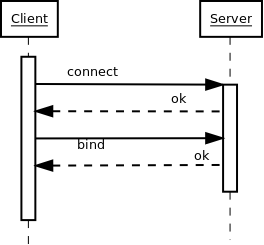
Doing a search¶
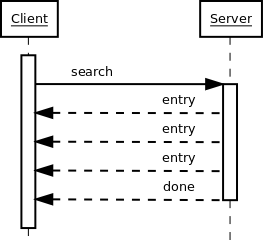
Doing multiple searches¶
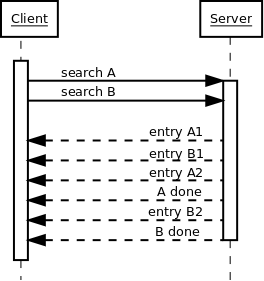
Unbinding and closing¶

A complex search filter¶
An example:
(&(objectClass=person)
(!(telephoneNumber=*))
(|(cn=*a*b*)(cn=*b*a*)))
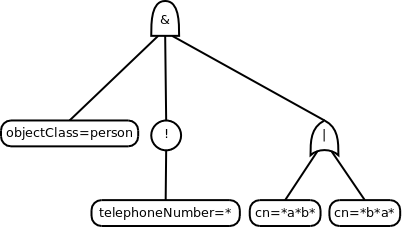
Object classes¶
Special attribute
objectClasslists all the objectclasses an LDAP entry manifests.- Objectclass defines
- What attributetypes an entry MUST have
- What attributetypes an entry MAY have
An entry in a phonebook must have a name and a telephone number, and may have a fax number and street address.
Schema¶
- A configuration file included in the LDAP server configuration.
- A combination of attribute type and object class definitions.
- Stored as plain text
- Can be requested over an LDAP connection
Attribute type¶
An example:
attributetype ( 2.5.4.4 NAME ( 'sn' 'surname' )
DESC 'RFC2256: last (family) name(s) for which the entity is known by'
SUP name )
Can also contain:
- content data type
- comparison and sort mechanism
- substring search mechanism
- whether multiple values are allowed
Object class¶
An example:
objectclass ( 2.5.6.6 NAME 'person'
DESC 'RFC2256: a person'
SUP top STRUCTURAL
MUST ( sn $ cn )
MAY ( userPassword $ telephoneNumber
$ seeAlso $ description )
)
Creating schemas¶
- Anyone can create their own schema
- Need to be globally unique
- But try to use already existing ones
Where to go from here?¶
Install OpenLDAP: http://www.openldap.org/
Install Ldaptor: https://github.com/twisted/ldaptor
Learn Python: http://www.python.org/
Learn Twisted. Write a client application for a simple protocol. Read the HOWTOs: http://twistedmatrix.com/documents/current/core/howto/clients.html